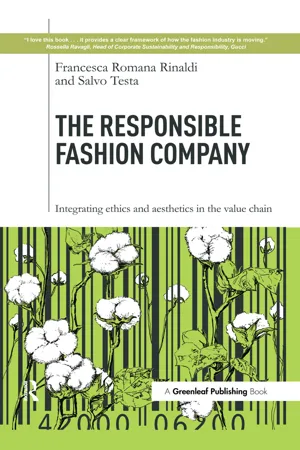
The Responsible Fashion Company
Integrating Ethics and Aesthetics in the Value Chain
- 240 pages
- English
- ePUB (mobile friendly)
- Available on iOS & Android
The Responsible Fashion Company
Integrating Ethics and Aesthetics in the Value Chain
About this book
In The Responsible Fashion Company, Rinaldi and Testa argue that the fashion industry is at a crossroads: the need for a global shift to a sustainable model has never been more urgent. Yet, they demonstrate that we are witnessing a revolution led by conscious consumers and enlightened companies, who are redefining the rules of the fashion market. The question is: when will the rest of the industry catch up?
Rinaldi and Testa raise a fundamental but often neglected issue in the fashion sustainability debate: long-term equilibrium can only be achieved by integrating economic goals with environmental, social and ethical values. "The Responsible Fashion Company" provides a clear overview of the theory, challenges and opportunities of sustainability in the industry and demonstrates how fashion companies can achieve competitive advantage through sustainable innovation. The authors show how leading fashion companies are challenging traditional thinking and present inspiring examples from pioneers such as Gucci, Levi's, Timberland and Brunello Cucinelli, who create quality products without leaving a negative impact behind.Refreshing and timely, The Responsible Fashion Company is essential reading for the socially conscious consumer and anyone with a professional or personal interest in the fashion, design and luxury industries.
Frequently asked questions
- Essential is ideal for learners and professionals who enjoy exploring a wide range of subjects. Access the Essential Library with 800,000+ trusted titles and best-sellers across business, personal growth, and the humanities. Includes unlimited reading time and Standard Read Aloud voice.
- Complete: Perfect for advanced learners and researchers needing full, unrestricted access. Unlock 1.4M+ books across hundreds of subjects, including academic and specialized titles. The Complete Plan also includes advanced features like Premium Read Aloud and Research Assistant.
Please note we cannot support devices running on iOS 13 and Android 7 or earlier. Learn more about using the app.
Information
1
The new paradigms
1.1 The new paradigms of consumption and information
- Converse, with the ‘Design Your Own’ project, allows clients to personalise every detail of their trainers, and to order the shoes via the company’s website for them to be delivered to their home two to three weeks later.
- Nike, with the ‘NIKEiD’ project, allows the upper, insole and laces of running shoes to be customised, and it is even possible to put an ‘iD’ on the shoe’s tongue.
- Burberry, with the customised line called ‘Bespoke’, represents an example of luxury customisation. Clients can buy the trench-coat of their dreams, after choosing every detail (fabric, colour, sleeves, lining, collar, buttons, metal parts, belt and label) from the comfort of their own home.
- Polygamy and infidelity to the brand. The new way of relating with the brand implies a progressive reappraisal of the brand’s actual ideology and growing power for the consumer.
- Nomadism. Intended both literally, for the increasing amount of travel from one city to another and from one country to another, and metaphorically, for the ‘continuous slalom among products, consumption styles, brands that are becoming the modus vivendi of the postmodern consumer […] could indeed be traditionalist in their choice of car and an experimenter in food, minimalist for house decor and exhibitionist in clothing, open to what is new with regards to intellectual consumption and conservative towards new technologies’.
- Competences, needs and selectivity. With the increase in both competition and available alternatives, as well as the transparency of product information guaranteed by the Internet, the neo-consumer is increasingly competent, demanding and selective. Today, consumers are informed (and increasingly want to be so) regarding the origin of the product, the production method and the type of labour used. Says Fabris: ‘Ethics, the widespread request by producers and sellers for socially responsible behaviour, attention to the consumption chain even including the countries of origin of the raw materials, the production methods, the workers’ fair salaries, the environmental impact due to production, right up to waste disposal’ represent the new critical factors for establishing a successful and trusting relationship with the neo-consumer.
- Price sensitivity. This characteristic is also influenced by the increase in competition and available alternatives, as well as by the transparency of product information which is guaranteed by the Internet.
- Polygamy, infidelity to the brand and price sensitivity. Brand infidelity is growing with the increasing number of channels through which one can obtain information and compare characteristics.
- Nomadism. The neo-consumer is a nomad even when choosing and using digital devices (smart phones, notebooks and tablet computers) to go online in order to obtain information and buy. Multichannel is the new mantra.
- Competence, need and selectivity. Thanks to information transparency guaranteed by the Internet, the neo-consumer can always be up to date regarding the origin of the product, the production method and the type of labour used.
1.2 The neo-consumer in fashion
Table of contents
- Cover
- Half Title
- Title
- Copyright
- Dedication
- Contents
- Foreword by Carlo Petrini
- Introduction
- 1 The new paradigms
- 2 The new value proposition: from the logic of profit to shared value
- 3 Fashion and the environment
- 4 Fashion and society
- 5 Fashion and the media
- 6 Fashion, art, culture and territory
- 7 Fashion, regulations and institutions
- 8 Brunello Cucinelli: an ethical and humanistic company
- 9 Ethics and fashion: towards a responsible value chain
- Multimedia resources
- About the authors